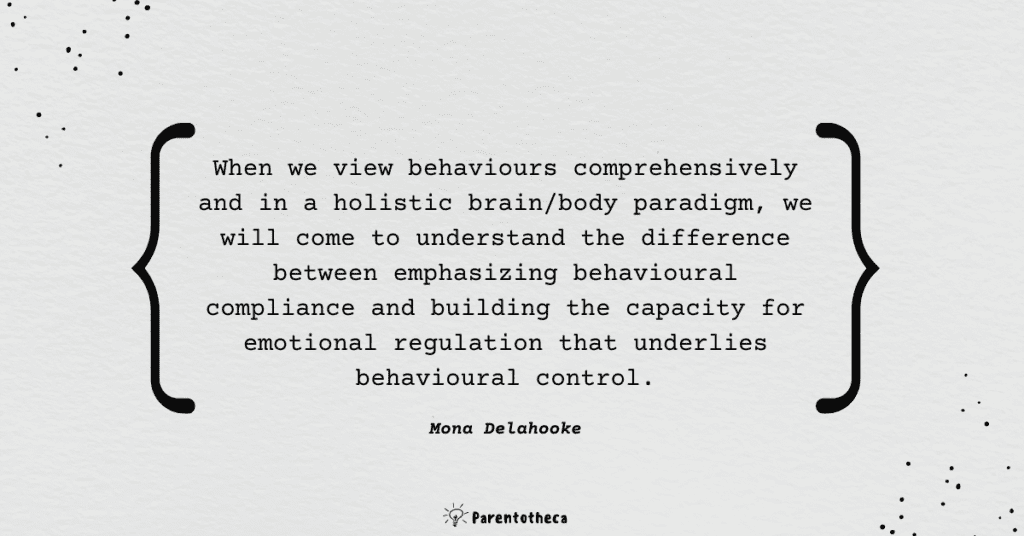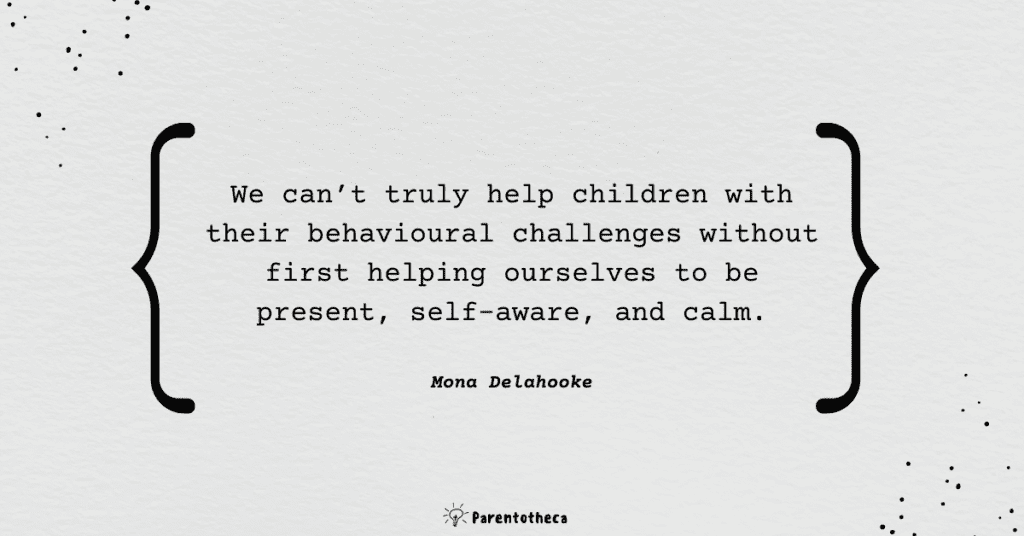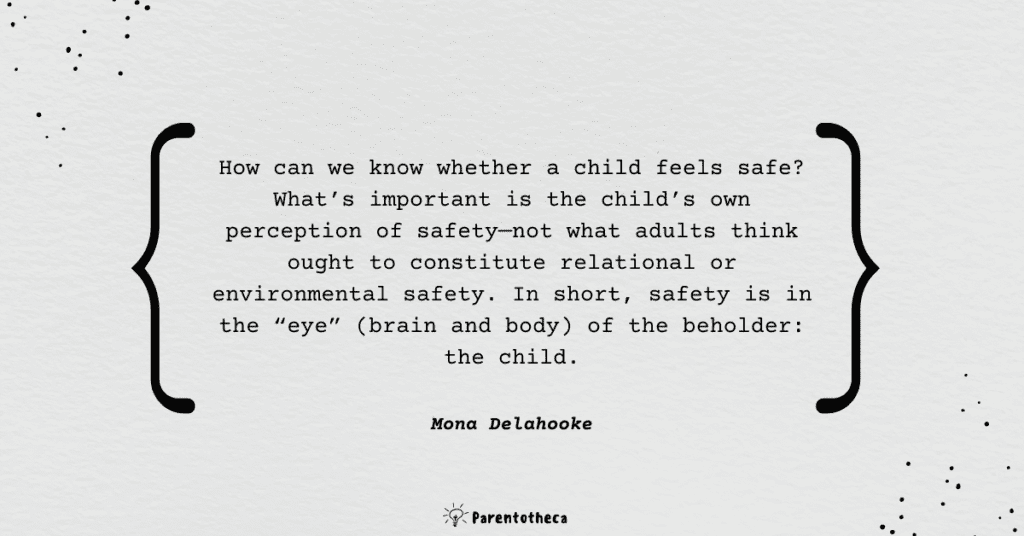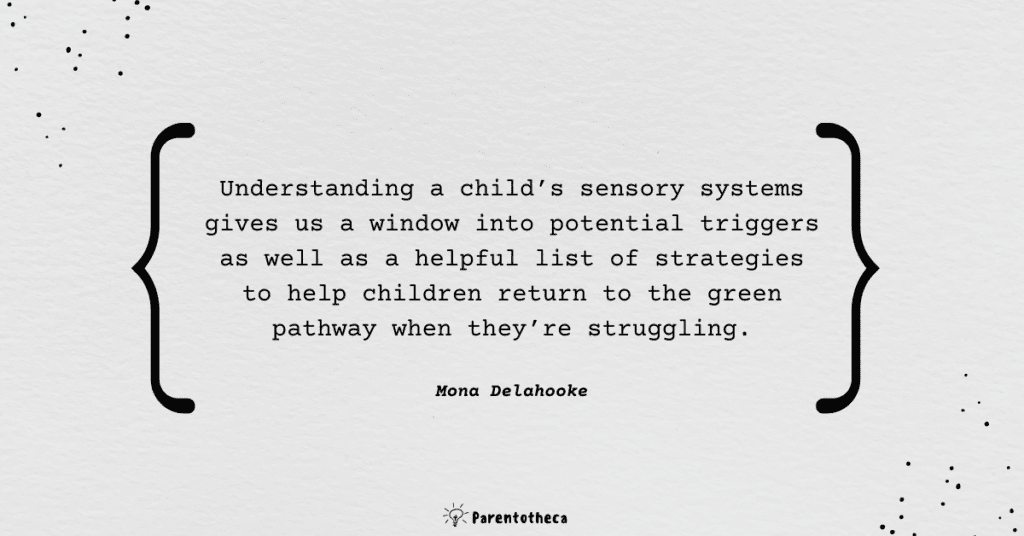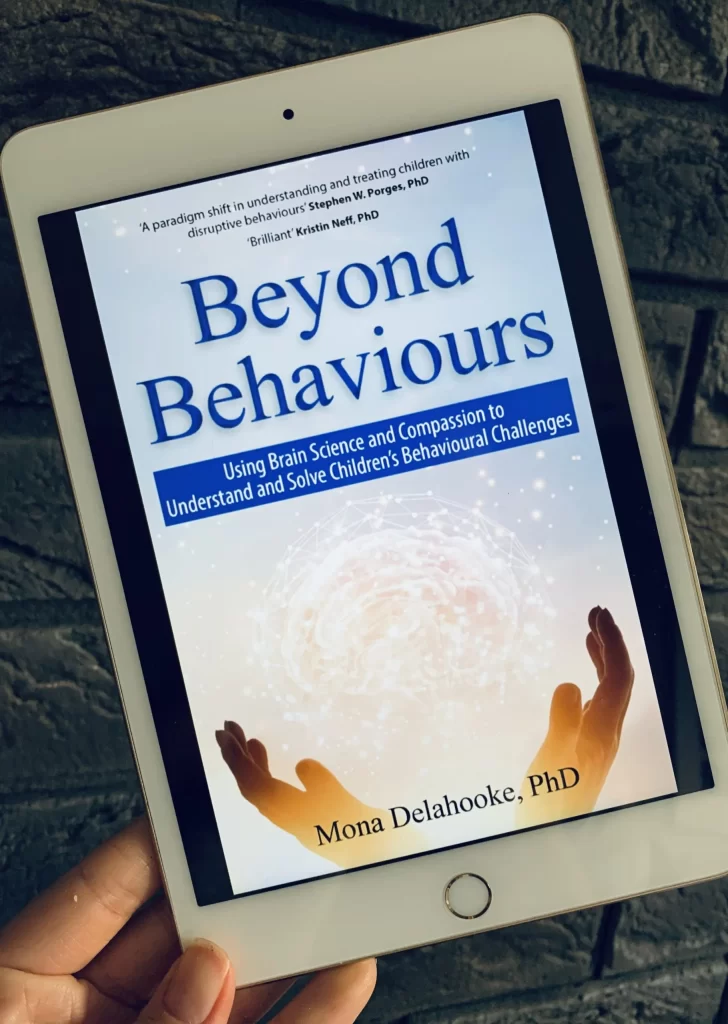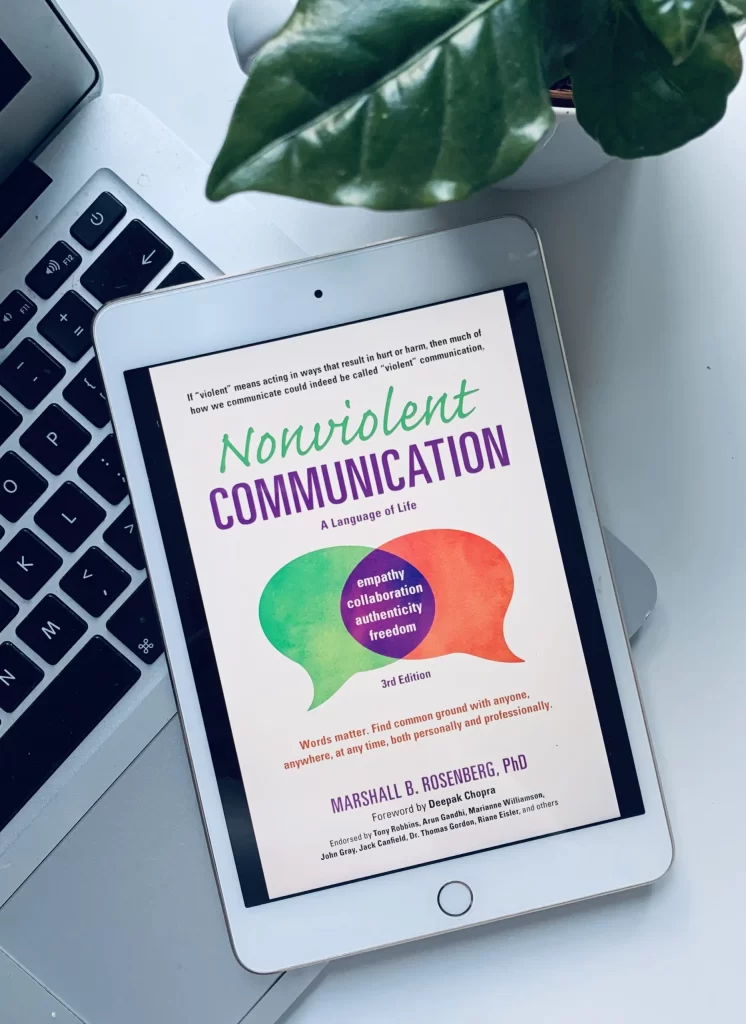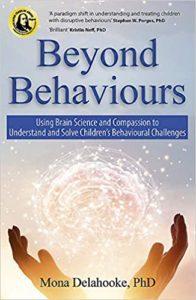 Beyond Behaviours. Book Summary
Beyond Behaviours. Book Summary
Using Brain Science and Compassion to Understand and Solve Children’s Behavioural Challenges
Mona Delahooke
John Murray Learning (19 Mar. 2020)
About the author
Mona Delahooke, PhD, is a licensed clinical psychologist with more than 30 years of experience. She is a senior faculty member of the Profectum Foundation and a trainer for the Los Angeles County Department of Mental Health.
She is a frequent speaker, trainer, and consultant to parents, organisations, schools, and public agencies. Dr Delahooke has dedicated her career to promoting compassionate, relationship-based, neurodevelopmental interventions for children with developmental, behavioural, emotional, and learning differences.
About the book:
“This book aims to provide a new context to understand behavioural challenges and offer a roadmap for making decisions based on each child’s brain and body. While research and knowledge about the brain has progressed exponentially over the past three decades, we have barely begun to translate this understanding into practical use.”
If you are a parent or a caregiver looking for practical solutions for managing children’s challenging behaviours, this book is a must-read. Here Mona Delahooke challenges us to look at behaviours differently and guides us towards a deeper understanding of why it is always important to consider brain development, the nervous system and individual differences.
The book is brilliant and PACKED with wisdom, real-life examples and practical TOOLS that you can use straight away. We’ll cover just a few big ideas in these notes, so definitely check out the book for more.
Key insights:
Behaviours have meaning
“Many professionals believe that problematic behaviours represent a child’s efforts to get something or to get out of something. We often blame a child’s behaviour challenges on “lax” parenting, or a diagnosis. Too often, we assume that what a child or teen needs is better behavioural management, more consistent parenting, or better medication. Current neuroscience, though, reveals a more complex reality: many problematic behaviours reflect how the child’s brain and body perceive stress.”
Every behaviour has meaning. We need to understand that children misbehave not because they want to give us a hard time but because, most likely, they are having a hard time. And this is a paradigm shift – instead of addressing the challenging behaviour itself, we need to figure out the roots of the problem first:
“…think of behaviours as the tip of an iceberg—that part of an individual that we readily see or know. The tip reveals answers to “what” questions about a person. Just as we can see only the tip of an iceberg, while most of it remains hidden underwater, we can observe childhood behaviours with the understanding that the many factors that contribute to them are hidden from view.”
In the book, Mona highlights that there are two different kinds of behaviours:
- Bottom-Up behaviours (instinctual and unintentional). They are basic survival-based stress responses. That’s when the “downstairs brain” is in control. And it’s crucial to understand that in young children, that part of the brain is dominant (especially in the first four years of their life).
- Top-Down behaviours (deliberate and intentional). Top-down thinking develops over many years (as the cerebral cortex develops). It allows us to control our impulses and behaviours, learn and reflect on our actions and pursue our goals. That’s what Dr Siegel and Dr Payne Bryson call the “upstairs brain” in their book The Whole-Brain Child.
These two types of behaviour have completely different causes, so they should be addressed differently. For example, if your toddler throws a tantrum because it’s time to leave the playground and go home, punishing him (e.g. “no screen time at home if you behave like that”) will not do any good. It’s a much better idea to start with helping the child feel safe and seen (btw, check out our article “5 Truths to Remember During Tantrums” for more insights on how to handle a toddler tantrum).
When your child shows challenging behaviour, the starting point is always to ask yourself: is it a bottom-up or a top-down behaviour?
Social-Emotional Development in a nutshell
“As much as we would like our children to be able to “use their words” and exert control over their own behaviour, none of us is born with that ability. The capacity to act with intention and to communicate one’s needs emerges through an extended process of development nurtured by attuned relationships.”
Every child is a work in progress. And if we address challenging behaviours from the point of view of a child’s physiological and emotional needs, we can see great results in the long-run.
To demonstrate how a human brain develops, Dr Delahooke uses the analogy of building a house:
- Foundation of the House: Regulation and attention (the most important part of the house – our ability to live in the body, stay calm and alert to focus and attend to the world around us)
- Framing the House: Engagement and Relating (experiencing and engaging in warmly connected relationships)
- The Electrical Wiring: Purposeful Emotional Interactions (ability to have a back-and-forth communication without using words)
- The Rooms of The House: Shared Social Problem Solving (purposeful non-verbal communication – telling or asking something)
- Decorating the House: Creating Symbols and Using Words and Ideas (ability to connect internal sensations, feelings, thoughts, and emotions to words, that leads to the ability to understand one’s own behaviours through top-down thinking)
- The Driveway to the World: Emotional Thinking and Building Bridges Between Ideas (ability to organise thoughts and emotions, ability to think logically and build bridges between own ideas and those of others)
Mona highlights that these processes are dynamic and can shift according to what a child is experiencing:
“The key is to survey where the child is in real time and always attend to the earliest area of challenge, starting from the foundation.”
To help a child with challenging behaviour, we need to assess the child’s socio-emotional development processes first and see where the gaps are. That also helps us understand whether behaviours are top-down or bottom-up.
Actually, true for adults as well – our own challenging behaviours can have roots in our socio-emotional development. So always good to be aware of it ☺
Autonomic nervous system – three states of arousal
Children (and adults as well) can be in one of three states of arousal (autonomic pathways of responses):
- Green pathway (Social Engagement) – a state when an individual can communicate, play and learn;
- Red pathway (Fight or Flight) – a child (or adult) may experience a racing heart, sweating, and other signs of activation. That’s when we are adaptively getting ready to react to a threat.
- Blue pathway (Shutting Down) – when we react to cues of extreme danger: an individual may experience a slower heart and breathing rate with a sluggish body. That’s when we preserve energy for the sake of survival.
These pathways are our radar, alerting us where a child needs help. Why is it important? In a nutshell, the “green pathway is the pathway that leads to healthy social and emotional development”. When a child is in a red or blue pathway, he is focused on survival and not on engagement and connection.
Obviously, every child would regularly cycle through gradations of the various pathways. Moreover, it’s actually healthy to be in a “light green” pathway from time to time – children need positive and tolerable stress to build resilience, grow and perform on a high level. That’s what Dr Stixrud and Ned Johnson call “stress immunisation” (check out our notes on their great book The Thriving Child). But we need to ensure that our child does not stay in a red or blue pathway for too long (that’s the sure way to chronic and toxic stress that impedes a child’s development).
It’s always a good idea to teach a child this concept and show them how it works in action. E.g. next time you get emotionally overwhelmed, take a deep breath, explain to a child that you are in the red pathway and say: “I really need a second now to calm down”.
We understand the world through our senses
“Sometimes, behavioural challenges are a child’s body’s way of coping with sensory challenges. Understanding a child’s sensory processing—how they interpret the world through their various senses—is an additional tool we can use to deconstruct the reasons for children’s behaviours. Sometimes, over- or under-reactivity in one or more of the sensory channels contributes to a child’s early behavioural and emotional disruption.”
Our sensory systems allow us to see, hear, smell, touch, taste and feel movement so that we can make sense of our experience. And each of us has a unique way to respond to the world around us. Sometimes, when children are over- or under- reactive through one or more sensory channels, this can add up to their emotional and psychological regulation and sense of safety (thus leading to red or blue pathway behaviours).
Therefore, we should keep in mind two questions:
“- What factors are affecting a child’s ability to have calm, focused, and alert attention in her body and mind?
– What impact does this have on his or her relationships and successful participation in daily activities at home and school?”
In the book, Mona shares great checklists that you can use to better understand your child’s sensory systems, so you can help them get back to the green pathway as soon as possible in case of distress.
Safety first
“When a child feels truly safe with a trusted adult, social engagement behaviours emerge naturally. When a child experiences the neuroception of safety, defensive strategies are “turned off”. In other words, the child doesn’t need to fight, run away or freeze up in order to feel safe on a subconscious level.”
This is so important. Especially for breaking generational cycles. To change the behaviour, a child needs to FEEL SAFE. And the safety of relationship is the key modulator of a child’s stress response.
If we punish a child for their behaviour, their feeling of safety is compromised. They get into a fight-or-flight mode, and they don’t learn the skills they need to change their behaviour.
For example, a child hits his sibling because he took his toy. The first thing a parent can say is: “Oh dear. I see that you are really angry. Your brother took your favourite car – you were playing with it, and it makes sense that you feel that upset about that. You are allowed to feel as angry for as long as you want to feel. I will not let you hit because no matter of how we feel, we don’t hit. But of course, you are allowed to feel angry. And if you want my help to figure out or show you how to feel the emotion in a safer way, I’m happy to do that, sweetheart. Can I give you a hug? I love you no matter how you feel.”
No threats, no punishment. Works miracles (we’ve tried it ☺).
P.S.: Check out the book for great practical worksheets.
Therapeutic use of self and emotional co-regulation
“It’s beneficial for adults to take notice of our own reactions, starting by checking in with ourselves to determine whether we are experiencing calm attention in our own bodies and minds. Our own awareness allows us to realise what kinds of emotional signals we are giving to children. Only then can we offer children what they need most when they are in distress: our calming presence to help them feel safe and calm again. This process of mutual support is known as emotional co-regulation.”
Emotional co-regulation. That’s the key to getting a child from a red (or blue) pathway back to the green one. The key here is to stay on a green pathway yourself and SEE a child in a moment of distress – show compassion and emotional attunement.
By the way, do you know that you can’t teach a child to self-regulate? We can teach them tools they can use when they are overwhelmed, but self-regulation itself is a neuro-developmental process – a child should EXPERIENCE it from an adult. That’s why we should always start with ourselves – BEEING before TEACHING. And it takes a lot of everyday practice. So pause and reflect. Especially when you notice that you are heading towards a red/blue pathway yourself.
It actually resonates with Dr Stixrud’s and Ned Johnson’s wisdom in The Thriving Child:
“Our anxiety is seeping into our kids. Children don’t need perfect parents, but they do benefit greatly from parents who can serve as a nonanxious presence. When we are not unduly stressed, worried, angry, or tired, we are much better able to comfort an infant, handle the behavioural challenges of young children, and respond to our teenager’s limitations without impulsively saying or doing something hurtful. When we can be a nonanxious presence for our children, we do a world of good – just by not freaking out. In fact, a recent study showed that other than showing your child love and affection, managing your own stress is the best thing you can do to be an effective parent.”
Always begin with yourself when dealing with children’s challenging behaviours. That’s the starting point. Period.
It also reminds me of Hal Runkel’s wisdom – in his brilliant book Screamfree Parenting he highlights that we can’t control our child’s behaviour (especially if it’s a bottom-up one). There is only one thing that is under our control – our OWN behaviour. So it’s crucial to stay calm and not to join the emotional storm.
How to stay calm and carry on? Two steps here:
- Work on your awareness (know your triggers)
- Apply the self-care to get back to green (figure out your own coping strategies based on self-kindness, a sense of common humanity, and mindfulness)
And a lot of practice, of course.
Top-down strategies for building self-regulation skills
When children are in distress (their downstairs brain is in charge), the best thing we can do is to co-regulate. But once they are back on the green pathway, we can teach them tools for self-regulation. Moreover, adults will benefit from them a lot as well. Here are a few strategies (check out the book – it’s packed with scripts and practical exercises):
- Mindfulness – teach a child to tune in to the body and mind (there is a simple exercise in the book, but you can use SIFT framework from The Whole-Brain Child).
- “Sending friendly wishes” exercise (sending blessings to themselves, friends, family and all the people in the world)
- Therapeutic play (free play is a good starting point)
- Teach a child to recognise and name their autonomic state (and help them develop their own solutions)
- Encourage top-down processing through our interactions and conversations (modelling top-down thinking through our own self-reflection)
In a nutshell, that’s the basics of Emotional Intelligence – developing self-awareness and the ability to manage feelings. Question for you – which strategy will you try today?
Action steps for you:
- Take a moment to assess your child’s socio-emotional development – where is s/he at this point? What are his sensory preferences?
- Think about what sets you off to the red/blue path – what are your triggers? Then, reflect on what helps you to calm down, be more present and self-aware. And practice co-regulation whenever you face a challenging time with your child ☺
- If you feel that you are heading towards a red pathway, try the Affectionate Breathing exercise.
Quotes from the book:

